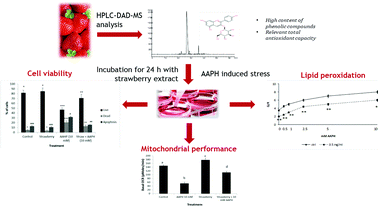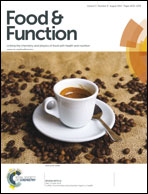An anthocyanin-rich strawberry extract protects against oxidative stress damage and improves mitochondrial functionality in human dermal fibroblasts exposed to an oxidizing agent
Abstract
This study investigates the protective effect of the Sveva strawberry polyphenol-rich extract on human dermal fibroblasts against AAPH-induced oxidative stress. The HPLC-DAD/ESI-MS analysis was used for evaluating the phenolic composition of the fruits. Sveva strawberry presented a high anthocyanin content (639.79 mg per kg fresh fruit), representing ∼86.08% of the total phenolic content, with Pg-3-glc as the most abundant representative (611.18 mg per kg fresh fruit). Only one ellagitannin (agrimoniin) was identified, while two quercetins, three kaempherol derivates, and three ellagic acid derivatives were detected and quantified. Strawberry pre-treatment (0.5 mg ml−1) markedly increased human dermal fibroblast viability, with a significant reduction of apoptotic and dead cells, and suppressed AAPH-induced ROS generation, after only 30 minutes of incubation with the oxidizing agent, and lipid peroxidation, against a range of AAPH concentrations tested. Notably, the strawberry extract also improved the mitochondrial functionality: the basal respiratory performance after treatment was ∼1.59-fold higher compared to control cells, while pre-treatment with strawberry extract before oxidative damage increased ∼2.70-fold compared to stressed cells. Our results confirm that the strawberry possesses antioxidant properties, and may be useful for the prevention of free radical-induced skin damage.


 Please wait while we load your content...
Please wait while we load your content...